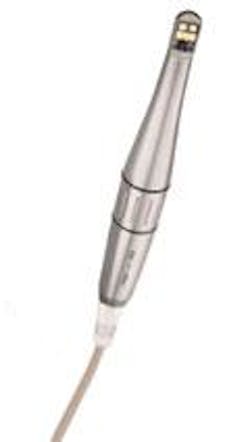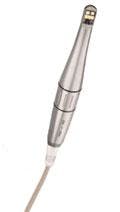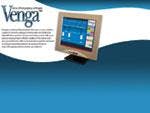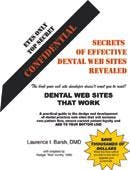The Ex Files
Paul Feuerstein, DMD
Allen Jorgensen, a computer wiz who also manages his wife Bridgett's dental office in Sugar Hill, Ga., posted a terrific view of a chartless office on InternetDentalForum.org. Jorgensen also is part of a consulting group that helps dentists get more out of their practice-management systems. With his permission, I'm sharing his exchange in this column.
"For anyone who works in a charted office, it's hard to imagine anything else. But try to envision for a moment how not creating a chart in the first place, or not having to commit to the life-long 'care and feeding' of a chart (a considerable expense) would significantly reduce your bottom line. Just think of how having access to vital patient information at the touch of a button would increase staff efficiency. Also consider that a computer chart can function as well or better than a paper chart, while the function of paper charts is limited. (When you get to the office tomorrow, walk up to your wall of charts and start asking it questions like, 'Anyone who needs a crown after root canal please slide two inches forward!' or 'Anyone who has been responsible for referring in $5,000 of dentistry ...' or 'Anyone that saw hygienist X ...'). After you are finished talking to your wall of charts (and after you tell the staff to stop giggling, because they will love this next step ...), begin copying every item in every chart. Then, take this "backup" somewhere off-site. This needs to be finished in less than 24 hours because you'll have to repeat it tomorrow, and the next day, and ...
"Now, do a chart audit on yourself. Randomly pull 10 different charts. Photocopy the progress notes 'as is,' and send them to any dental school instructor for grading. Are these notes written with the thoroughness and clarity that we all started with? Once an office has transitioned to 'chartlessness,' these steps become child's play.
"All dentists have been around charts since day one. The evolution of the chart has been one that was a best practice at the time with the best materials at the time. Somewhere, though, we stopped making progress, and the same old methods have endured through generations.
"In 1996, I left a world where I traveled nonstop to solve problems with technology and systems, and instead found myself knee deep in a small business — my wife's practice — that had very nice, well-intentioned people who assured me I had to learn how to build a chart! My 'outsiders' perspective was (and still is) that what the majority of dental/medical offices do is nuts! There are no successful businesses that document their operations with such an archaic solution. We implemented a chartless system almost immediately, and we haven't looked back.
"The benefit for you and your patients is the amount and quality of information you will have at your fingertips to provide the best care possible. Your patients will receive better service because your staff will be empowered to do the correct work at the correct time with minimum effort and maximum return. Converting to a chartless system doesn't require any fundamental changes to your office. You already have the tools to begin — you just need the instructions on how to do the transition. You aren't creating a 'paperless' office — paper will still be used, but in a different way, and with more protection for you and your office.
"Nothing was really broken with the 'peg-board' system of paper charts, yet after running a modern, sophisticated practice-management system, it's hard to imagine how anyone ever used that system. The same degree of practice enhancement occurs during the transition between chart-based versus screen-based. This phenomenon took over the business world in the 1960s and 1970s. Even hospitals are further ahead than most dental offices. The initial costs to implement this type of system from scratch may seem overwhelming, but the savings reaped from the increased efficiency are worth it. However, most offices already have the basic tools to begin and so can implement a chartless system with little to no investment. A little guidance is all that's needed. Just like Dorothy — all they need is a visit to the 'wizard' to learn how to click their mouse three times ... and they will be at a far better place!"
Jorgensen may be reached at allen@lighthouse- pmg.com, or call him at (770) 932-0992.
Dr. Paul Feuerstein installed one of dentistry's first computers in 1978. For more than 20 years, he has taught courses on technology throughout the country. He is a mainstay at technology sessions, including annual appearances at the Yankee.Dental Congress, and has been a part of the ADA's Technology Day since its inception. A general practitioner in North Billerica, Mass., since 1973, Dr. Feuerstein maintains a Web site (www.computersindentistry.com) and can be reached by email at [email protected].
A-dec intraoral camera. Here is a sleek unit that fits right in a hangar next to the hand pieces and is activated when it is lifted out. The unit's existing foot control has a live/freeze function. LEDs are bright, run cool, last long, and don't require a heavy fiberoptic cable. The focus runs from macro close-up to full face. www.a-dec.com.
VENGA intra office paging software. This product puts the traditional light communication system on the office computer network. Messages can be sent using color-coded buttons or text messages. Venga can be configured for up to 24 staff members and 26 rooms. www.venga info.com.
Dental Web Sites That Work — This book by Larry Barsh, DMD is a primer in setting up an office Web site. Whether you are designing your own site or hiring someone to do it, this book will give you a foundation to make practical design decisions. Rod Kurthy, DMD also adds some sound marketing ideas. www.adlibdesign.com.
Topaz Systems e-Signature Capture Pad from EagleSoft
Digital signatures can now be taken with a Topaz systems capture pad. This device is similar to those seen in retail store credit card units. This signature is another step toward the paperless practice, and, according to HIPAAdvisory, a digital signature cannot be forged, making it more "tamper-proof" than a paper copy. patterson.eaglesoft.net.



